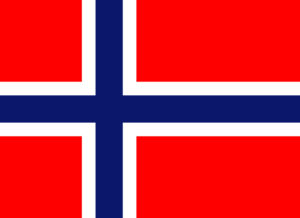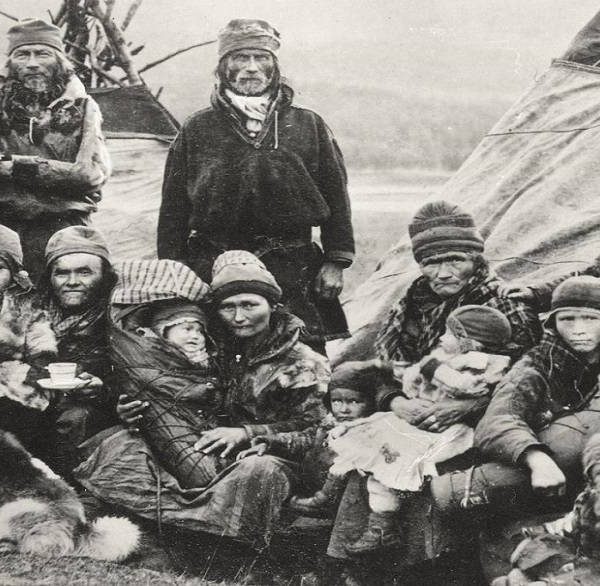![]() Det finnes flere teorier om samefolkets opphav, hvor de er kommet fra og hvilke folkegrupper de eventuelt er i slekt med. Gamle samiske myter forteller om lange vandringer før samene endelig kom fram til det landet som de i dag kaller Sápmi eller Sámiid eanan. De eldste av disse mytene slutter med den tiden da samene begynte å tro på den sjamanistiske religionsformen, altså den samiske religionen som senere kristne misjonærer bekjempet. Mytene forteller om en todelt innvandring til Sameland, en fra nord og en fra sør
Det finnes flere teorier om samefolkets opphav, hvor de er kommet fra og hvilke folkegrupper de eventuelt er i slekt med. Gamle samiske myter forteller om lange vandringer før samene endelig kom fram til det landet som de i dag kaller Sápmi eller Sámiid eanan. De eldste av disse mytene slutter med den tiden da samene begynte å tro på den sjamanistiske religionsformen, altså den samiske religionen som senere kristne misjonærer bekjempet. Mytene forteller om en todelt innvandring til Sameland, en fra nord og en fra sør
.
![]() There are several theories about the origins of the common people, where they came from and which peoples groups they may be related to. Old Sami myths tell of long migrations before the Sami finally arrived in the land they now call Sápmi or Sámiid eanan. The oldest of these myths ends with the time when the Sami began to believe in the shamanistic form of religion, that is, the Sami religion that later Christian missionaries fought. The myths tell of a two-part immigration to Sameland, one from the north and one from the south.
There are several theories about the origins of the common people, where they came from and which peoples groups they may be related to. Old Sami myths tell of long migrations before the Sami finally arrived in the land they now call Sápmi or Sámiid eanan. The oldest of these myths ends with the time when the Sami began to believe in the shamanistic form of religion, that is, the Sami religion that later Christian missionaries fought. The myths tell of a two-part immigration to Sameland, one from the north and one from the south.
 Forhistorie
Forhistorie
De gamle samene var et fangst- og jegerfolk. Dette bekreftes blant annet av arkeologiske utgravninger og av den eldste litterære kilden vi har til samenes historie, nemlig Tacitus‘ beskrivelse av fenni i hans verk Germania fra 98 e.Kr.
Et av de eldste jordfunnene som man går ut fra at er samisk, er gjort på Kjelmøya i Sør-Varanger. Det dreier seg tydeligvis om en sesongboplass for sjøfangsten, og det er funnet et rikt utvalg av fangstredskaper, nesten alle av bein. De eldste kulturlagene går tilbake til tiden omkring år null. Spørsmålet er når den etniske utskillelsen skjedde, altså på hvilket tidspunkt og på hvilken måte det eventuelt vil være mulig på basis av funn og utgravninger å si at dette viser en samisk bosetning i området.
Den gamle samiske samfunnsordningen var basert på et siida–system, der ulike jaktlag til sammen dannet grunnlaget for større fellesenheter, en «sameby» eller bygdeenhet. Disse siida-ene hadde et gjennomført demokratisk styresett, der bosetningen var basert på økologisk tilpasning og flytting etter resursene. De fleste siida-ene opererte med flere sesongboplasser, der man til enhver tid utnyttet de naturrikdommene som det var mest av på stedet. Antagelig var også siida-ordningen noe av årsaken til at man unngikk altfor mange konfrontasjoner mellom samer og nordmenn på det tidspunktet koloniseringen satte inn for fullt. Samene trakk seg unna til en av de andre boplassene for å unngå strid, men fikk samtidig redusert sin aksjonsradius og sin tilgang på byttedyr.
 prehistory
prehistory
The ancient Sami were a hunting people. This is confirmed, among other things, by archaeological excavations and by the oldest literary source we have for the history of the Sami, namely Tacitus’ description of fenni in his work Germania from 98 AD.
One of the oldest finds that is believed to be Sami was made at Kjelmøya in Sør-Varanger. Obviously, this is a seasonal catch for sea fishing, and a rich selection of fishing gear has been found, almost all of them bones. The oldest cultural layers date back to time around year zero. The question is when the ethnic separation happened, ie at what time and in what way it would be possible, on the basis of discoveries and excavations, to say that this shows a Sami settlement in the area.
The old Sami social order was based on a siida system, where different hunting teams together formed the basis for larger community units, a «Sami village» or a rural unit. These siida’s had a well-established democratic regime, where the settlement was based on ecological adaptation and relocation according to resources. Most of the siida’s operated with several seasonal settlements, utilizing the natural resources that were most of the place at all times. Presumably, the siida system was also one of the reasons for avoiding too many confrontations between Sami and Norwegians at the time of colonization. The Sami withdrew to one of the other settlements to avoid conflict, but at the same time reduced their radius of action and access to prey.
 Kolonisering og skattlegging
Kolonisering og skattlegging
Koloniseringen startet først ute ved kysten, men trakk seg gradvis innover i fjordene og opp langs elvene. Som en følge av koloniseringen tapte samene etter hvert sin autonomi. De ulike gruppene bodde så spredt og var så lite samlet at de aldri klarte å mobilisere noen større opposisjon mot tapet av land og vann.
Den sterke utnyttingen av naturgrunnlaget som fulgte med økt skattlegging og kolonisering, førte også til at det gamle veidesamfunnet mer og mer måtte gi tapt. Det ble erstattet av en næringsmessig differensiering som blant annet gikk ut på en snevrere utnyttelse av færre nisjer. På denne bakgrunnen oppstod tamreindriften, feholdet, sjø- og elvefisket og utmarksnæringene. Man la altså mer vekt på å utnytte én nisje som hovednæringsvei fremfor å satse på et vekselbruk der man kombinerte alle mulighetene.
Allerede tidlig ble samene utsatt for både røvertokter og skattlegging fra de omkringboende folkene. En del samegrupper ble faktisk til tider skattlagt av tre forskjellige land: både Danmark-Norge, Sverige-Finland og Russland.
 Colonization and taxation
Colonization and taxation
Colonization first started offshore, but gradually moved inward into the fjords and up the rivers. As a result of the colonization, the Sami gradually lost their autonomy. The various groups lived so widely and were so small that they never succeeded in mobilizing any major opposition to the loss of land and water.
The strong exploitation of the natural basis that came with increased taxation and colonization also led to the loss of the old road community. It was replaced by a business differentiation that included, among other things, a narrower utilization of fewer niches. Against this backdrop arose the domestic reindeer herding, the herding, the sea and river fishing and the outlying industries. In other words, more emphasis was placed on utilizing one niche as the main trade route rather than focusing on an exchange where they combined all the possibilities.
Early on, the Sami were exposed to both robbery and taxation from the surrounding people. In fact, some Sami groups were sometimes taxed by three different countries: Denmark-Norway, Sweden-Finland and Russia.
 Forholdet til nordmennene
Forholdet til nordmennene
I sagaene fortelles det at de norske kongene hadde mange forbindelser til samene. Harald Hårfagre skal ha vært gift med en samisk kvinne, og en av sønnene deres skal ha vært seidmann (sjaman). Eirik Blodøks‘ kone, Gunnhild, ble påstått å ha vokst opp hos samer, og der skal hun ha lært trolldommen hun angivelig drev med. I Harald Hårfagres saga fortelles det at da Eirik møtte Gunnhild, var hun på flukt fra to samiske menn som begge ville gifte seg med henne. Gunnhild greide imidlertid å drepe begge, her i Christian Kroghs tolkning.
Vi vet at for eksempel at vikingene reiste nordover for å plyndre og røve, men i andre tilfeller også for å skaffe seg båter og rådføre seg med de samiske sjamanene. Samene ved kysten var nemlig kjent som dyktige båtbyggere allerede fra sagatiden, og samiske sjamaner, noaiddit, har nordmenn alltid hatt respekt for.
Det eksisterer utallige historier om noaidenes bragder, både når det gjelder å bringe til veie informasjon om det som skjer andre steder enn der man selv befinner seg for øyeblikket, og om deres evner når det gjaldt å bruke trolldom. Sjamanen var en viktig institusjon i det gamle samiske samfunnet; han var den som tok vare på og formidlet videre myter og riter, og han kunne nok også skape nye ritualer.
 Relationship with the Norwegians
Relationship with the Norwegians
The saga tells that the Norwegian kings had many connections to the Sami. Harald Hårfagre is said to have been married to a Sami woman, and one of their sons must have been a shaman (shaman). Eirik Blodøks’ wife, Gunnhild, was alleged to have grown up with Sami, and there she must have learned the sorcery she allegedly operated with. In Harald Hårfagres saga it is told that when Eirik met Gunnhild, she was on the run from two Sami men who both wanted to marry her. However, Gunnhild managed to kill both, here in Christian Krogh’s interpretation.
We know, for example, that the Vikings traveled north to plunder and rob, but in other cases also to get boats and consult with the Sami shamans. Namely, the Sami on the coast were known as skilled boat builders from the Saga period, and Sami shamans, noaiddit, Norwegians have always had respect for.
There are countless stories about the accomplishments of the Noaids, both in bringing information about what is happening other than where you are at the moment, and about their abilities when it comes to using sorcery. The Shaman was an important institution in ancient Sami society; he was the one who took care of and conveyed myths and rites, and he could probably also create new rituals.

